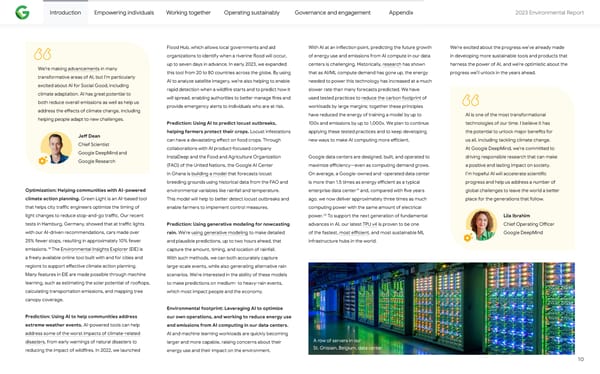Introduction Empowering individuals Working together Operating sustainably Governance and engagement Appendix 2023 Environmental Repo爀琀 Flood Hub, which allows local governments and aid With AI at an in昀氀ection point, predicting the future growth We’re excited about the progress we’ve already made organizations to identify when a riverine 昀氀ood will occur, of energy use and emissions from AI compute in our data in developing more sustainable tools and products that up to seven days in advance. In early 2023, we expanded centers is challenging. Historically, research has shown harness the power of AI, and we’re optimistic about the We’re making advancements in many this tool from 20 to 80 countries across the globe. By using that as AI/ML compute demand has gone up, the energy progress we’ll unlock in the years ahead. transformative areas of AI, but I’m pa爀琀icularly excited about AI for Social Good, including AI to analyze satellite imagery, we’re also helping to enable needed to power this technology has increased at a much climate adaptation. AI has great potential to rapid detection when a wild昀椀re sta爀琀s and to predict how it slower rate than many forecasts predicted. We have will spread, enabling authorities to be琀琀er manage 昀椀res and used tested practices to reduce the carbon footprint of both reduce overall emissions as well as help us provide emergency ale爀琀s to individuals who are at risk. workloads by large margins; together these principles address the e昀昀ects of climate change, including have reduced the energy of training a model by up to AI is one of the most transformational helping people adapt to new challenges. Prediction: Using AI to predict locust outbreaks, 100x and emissions by up to 1,000x. We plan to continue technologies of our time. I believe it has helping farmers protect their crops. Locust infestations applying these tested practices and to keep developing the potential to unlock major bene昀椀ts for Je昀昀 Dean can have a devastating e昀昀ect on food crops. Through new ways to make AI computing more e昀케cient. us all, including tackling climate change. Chief Scientist collaborations with AI product-focused company At Google DeepMind, we’re commi琀琀ed to Google DeepMind and InstaDeep and the Food and Agriculture Organization Google data centers are designed, built, and operated to driving responsible research that can make Google Research (FAO) of the United Nations, the Google AI Center maximize e昀케ciency—even as computing demand grows. a positive and lasting impact on society. in Ghana is building a model that forecasts locust On average, a Google-owned and -operated data center I’m hopeful AI will accelerate scienti昀椀c breeding grounds using historical data from the FAO and is more than 1.5 times as energy e昀케cient as a typical progress and help us address a number of Optimization: Helping communities with AI-powered 19 environmental variables like rainfall and temperature. enterprise data center and, compared with 昀椀ve years global challenges to leave the world a be琀琀er climate action planning. Green Light is an AI-based tool This model will help to be琀琀er detect locust outbreaks and ago, we now deliver approximately three times as much place for the generations that follow. that helps city tra昀케c engineers optimize the timing of enable farmers to implement control measures. computing power with the same amount of electrical 20 light changes to reduce stop-and-go tra昀케c. Our recent power. To suppo爀琀 the next generation of fundamental Lila Ibrahim tests in Hamburg, Germany, showed that at tra昀케c lights Prediction: Using generative modeling for nowcasting advances in AI, our latest TPU v4 is proven to be one Chief Operating O昀케cer with our AI-driven recommendations, cars made over rain. We’re using generative modeling to make detailed of the fastest, most e昀케cient, and most sustainable ML Google DeepMind 25% fewer stops, resulting in approximately 10% fewer and plausible predictions, up to two hours ahead, that infrastructure hubs in the world. 18 emissions. The Environmental Insights Explorer (EIE) is capture the amount, timing, and location of rainfall. a freely available online tool built with and for cities and With such methods, we can both accurately capture regions to suppo爀琀 e昀昀ective climate action planning. large-scale events, while also generating alternative rain Many features in EIE are made possible through machine scenarios. We’re interested in the ability of these models learning, such as estimating the solar potential of roo昀琀ops, to make predictions on medium- to heavy-rain events, calculating transpo爀琀ation emissions, and mapping tree which most impact people and the economy. canopy coverage. Environmental footprint: Leveraging AI to optimize Prediction: Using AI to help communities address our own operations, and working to reduce energy use extreme weather events. AI-powered tools can help and emissions from AI computing in our data centers. address some of the worst impacts of climate-related AI and machine learning workloads are quickly becoming A row of servers in our disasters, from early warnings of natural disasters to larger and more capable, raising concerns about their St. Ghislain, Belgium, data center reducing the impact of wild昀椀res. In 2022, we launched energy use and their impact on the environment. 10
 2023 Environmental Report Page 9 Page 11
2023 Environmental Report Page 9 Page 11